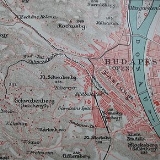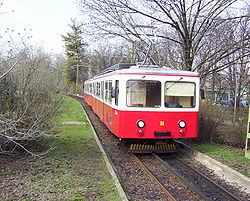
Budapest Cog-wheel Railway
Encyclopedia
The Budapest Cog-wheel Railway, officially called Tram line number 60, is a rack railway
running in Budapest
, Hungary
.
 Since 1868 a horse tramway ran on schedule from the Lánchíd
Since 1868 a horse tramway ran on schedule from the Lánchíd
to Zugliget set in operation by the Budai Közúti Vaspálya Társaság (~ Public Railway Society of Buda). Nikolaus Riggenbach (the designer of the first European cog-wheel train line of Vitznau-Rig opened in 1871) with a colleague of his as the representatives of the Internationale Gesellschaft für Bergbahnen applied for the construction of the cog-wheel train line
leading to Svábhegy. The building permit was issued on July 3, 1873, and construction of the line began immediately, thus enabling the service to start up in the following year. The first introductory vehicle ran from 4 p.m. on June 24, 1874, and regular traffic began on the following day. The whole line was built according to Riggenbach's cog-wheel system. The normal-gauge
single track railway was 2883 m (1.56 miles) long all the way uphill with a the difference in height of 264 m. The terminal point was built at the present Városmajor.
 Successful operation of the cog-wheel railway raised the issue of extending the line. The plan was brought to fruition in 1890, when traffic started to the Széchenyi Mountain increasing the length of the line to 3700 m. From July 2, 1929, the new electrically powered vehicles ran every 15 minutes. 1973 saw a full reconstruction, during which the whole track was renewed and new vehicles introduced. The older trains last ran on 15 March 1973 and traffic using the new vehicles began on 20 August of the same year.
Successful operation of the cog-wheel railway raised the issue of extending the line. The plan was brought to fruition in 1890, when traffic started to the Széchenyi Mountain increasing the length of the line to 3700 m. From July 2, 1929, the new electrically powered vehicles ran every 15 minutes. 1973 saw a full reconstruction, during which the whole track was renewed and new vehicles introduced. The older trains last ran on 15 March 1973 and traffic using the new vehicles began on 20 August of the same year.
(VEKE) is advocating that the line be extended in both directions (Normafa
and Széll Kálmán tér).
Rack railway
A rack-and-pinion railway is a railway with a toothed rack rail, usually between the running rails. The trains are fitted with one or more cog wheels or pinions that mesh with this rack rail...
running in Budapest
Budapest
Budapest is the capital of Hungary. As the largest city of Hungary, it is the country's principal political, cultural, commercial, industrial, and transportation centre. In 2011, Budapest had 1,733,685 inhabitants, down from its 1989 peak of 2,113,645 due to suburbanization. The Budapest Commuter...
, Hungary
Hungary
Hungary , officially the Republic of Hungary , is a landlocked country in Central Europe. It is situated in the Carpathian Basin and is bordered by Slovakia to the north, Ukraine and Romania to the east, Serbia and Croatia to the south, Slovenia to the southwest and Austria to the west. The...
.
History

Széchenyi Chain Bridge
The Széchenyi Chain Bridge is a suspension bridge that spans the River Danube between Buda and Pest, the western and eastern sides of Budapest, the capital of Hungary...
to Zugliget set in operation by the Budai Közúti Vaspálya Társaság (~ Public Railway Society of Buda). Nikolaus Riggenbach (the designer of the first European cog-wheel train line of Vitznau-Rig opened in 1871) with a colleague of his as the representatives of the Internationale Gesellschaft für Bergbahnen applied for the construction of the cog-wheel train line
Rack railway
A rack-and-pinion railway is a railway with a toothed rack rail, usually between the running rails. The trains are fitted with one or more cog wheels or pinions that mesh with this rack rail...
leading to Svábhegy. The building permit was issued on July 3, 1873, and construction of the line began immediately, thus enabling the service to start up in the following year. The first introductory vehicle ran from 4 p.m. on June 24, 1874, and regular traffic began on the following day. The whole line was built according to Riggenbach's cog-wheel system. The normal-gauge
Standard gauge
The standard gauge is a widely-used track gauge . Approximately 60% of the world's existing railway lines are built to this gauge...
single track railway was 2883 m (1.56 miles) long all the way uphill with a the difference in height of 264 m. The terminal point was built at the present Városmajor.

Future developments
The Urban and Suburban Transit AssociationUrban and Suburban Transit Association
The Urban and Suburban Transit Association is a Hungarian non-profit organization, aimed at developing city transport in Hungary.-Organizational structure:...
(VEKE) is advocating that the line be extended in both directions (Normafa
Normafa
A spot frequented by denizens of Budapest in the Buda hills, Normafa is known for its panoramic scenery and fresh air. It is located on Svábhegy and is in close proximity to Jánoshegy, the highest point in Budapest....
and Széll Kálmán tér).

